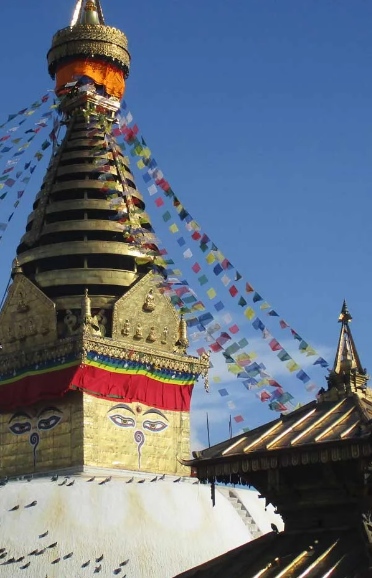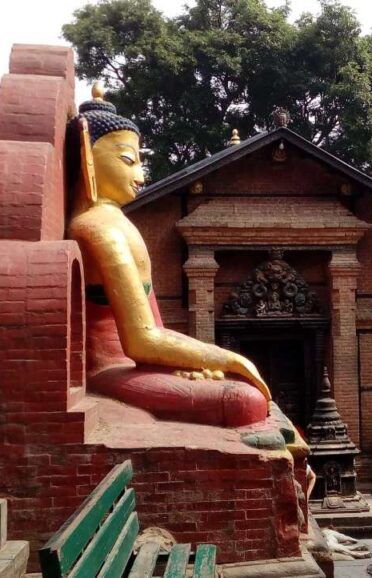Swayambhu is one of the most iconic and sacred sites in Kathmandu, Nepal. This ancient religious complex sits atop a hill in the Kathmandu Valley and is renowned for its historical and cultural significance.
Swayambhu is a UNESCO World Heritage Site and holds a special place in both Hinduism and Buddhism. The complex includes a stupa, a variety of shrines, temples, and prayer wheels, making it a pilgrimage destination for adherents of both religions. The central stupa, with its gilded spire and the all-seeing eyes of the Buddha, is a distinctive and recognizable symbol of Nepal.
The site offers breathtaking panoramic views of the Kathmandu Valley and the surrounding Himalayan mountains, making it not only a religious center but also a popular tourist attraction. Swayambhu is known for its resident monkey population, which has earned it the nickname “Monkey Temple.”
Visitors to Swayambhu can explore its rich history, soak in the spiritual atmosphere, and enjoy the serene surroundings while gaining insights into the cultural and religious tapestry of Nepal. It remains a place of worship, meditation, and reflection for both locals and tourists alike.
Facts about Swayambhu
- There is a history behind it, Swayambhu Purana tells Swayambhunath emerged out of a lotus flower.
- Emperor Ashoka in Indian history is said to have visited the site in the 3rd century BCE.
- The main festivals celebrated at Swayambhunath are Buddha Jayanti(in April or May) and a month-long Gunla celebration (in August or September).
"स्वयम्भूको पुरानो नाम पद्मकण्ठगिरी हो।"
"The ancient name of Swayambhu is Padmakanthagiri."

About Swayambhu stupa
It is one of the holiest Buddhist shrines and is part of a UNESCO World Heritage since 1979.
According to Swayambhu Purana (Buddhist scripture about the origin of Kathmandu valley and …

Harati Devi Temple
Located on the northwestern side of the Stupa, Goddess Harati is known as Harati maa and Ajima in Nepalbhasa (Newari language).
The Goddess in Kathmandu Valley to protect children from diseases or epidemics. She was stealing children and devouring them.
Shantipur
a man who is still alive here from 5th century
Northwest of the main stupa is another important shrine known as Shantipur. It is also called Akashpur (Sky Place) which represents the fifth element and has a fascinating legend.

Nagpur
It was built to appease the snake spirits in the Kathmandu Valley.
It is a pit infront of the Amoghasiddhi Buddha and on the northern side of the Swayambhunath stupa which is rectangular in shape with a snake idol at the bottom of it.

Who are Buddhists?
Those people follow the teachings of the Gautam Buddha and live by his teachings. Buddhists are followers of Buddhism, a major world religion and philosophical system founded in India in the 6th century BCE by Siddhartha Gautama, who is commonly known as the Buddha. Buddhism has since spread across the world, and its adherents, known as Buddhists, can be found in many countries.
Buddhism is a diverse and complex religion with a rich history and a wide range of practices and beliefs. Buddhists may vary in their specific beliefs and practices depending on the Buddhist tradition they follow and their cultural context. It is estimated that there are hundreds of millions of Buddhists around the world, making it one of the world’s major religions.
Who is the Buddha?
The one, who acquires the merits after several births, who has attained perfect wisdom or enlightenment or Nirvana is the Buddha.
What is Nirvana in Buddhism and how do we attain Nirvana?
Nirvana is the cessation of suffering. It is a blissful and peaceful state. we attain Nirvana if we follow Arya Astangik Marg. Nirvana is a central concept in Buddhism, and it represents the ultimate goal of the Buddhist path. It is a state of liberation, enlightenment, and profound peace. Nirvana signifies the end of suffering and the cycle of birth, death, and rebirth (samsara) that is central to Buddhist cosmology.
It’s important to note that the concept of Nirvana can be quite nuanced and may be understood differently in various Buddhist schools and traditions. Some Buddhists believe in the possibility of attaining Nirvana in this lifetime (as arhats or fully enlightened beings), while others aspire to it over multiple lifetimes. Ultimately, the pursuit of Nirvana is a deeply personal and spiritual journey in Buddhism.
